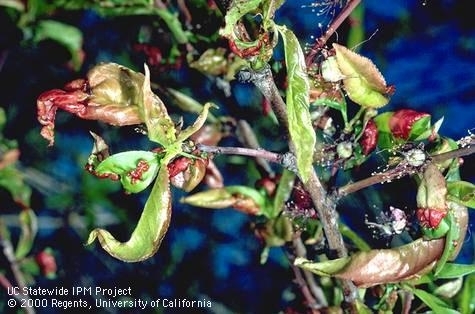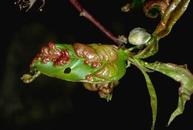
The disease that causes this problem with Peach and Nectarine trees is called Peach Leaf Curl, a fungal disease that affects the leaves and shoots of Peaches and Nectarines. The problem is very widespread and most people who have grown Peaches or Nectarines in their backyard in Alameda County probably have seen this problem at some point in time.
See UC Integrated Pest Management page for photos and further descriptions of the disease.
Signs of Peach Leaf Curl

Your Peach or Nectarine Will Survive
Gardeners are often discouraged to hear that once it appears on their trees in a given season, there is no method of effective treatment for that season. Peach Leaf Curl will cause the leaves to fall off and the fruit production of the tree can be affected. However, gardeners are usually relieved to hear that this disease rarely kills trees and can be easily managed if treated with a fungicide during the dormant season.
What is the Cause of Peach Leaf Curl
Taphina deformans is the fungus that causes Peach Leaf Curl. Periods of cool, wet weather when leaves are beginning to unfurl create a favorable environment for the fungus. Maximum infection develops when the trees are wet for two or more days during this vulnerable period.
How to Control Peach Leaf Curl ...fungicide in fall
To control Peach Leaf Curl, treat Peach and Nectarine trees with a fungicide in the fall after leaves have dropped. In the past, the disease could be successfully treated with either lime-sulfur fungicide or a fixed copper fungicide with a copper compound containing at least 50 percent copper. Unfortunately, the most effective products have been removed from the market by the manufacturer. The only fungicides left for treating Peach Leaf Curl contain lower levels of copper and copper soap (see references below).
Fungicide hints … add horticultural oil, spray twice
You can make the copper ammonium complex products more effective by adding horticultural oil to the treatment mixture. The oil, which should be one percent of the mixture, also helps control some insects that affect the trees. Spray your trees twice, the first time in late November and the second time in early February. A handy trick for remembering those dates is to spray right after Thanksgiving and just before Valentine's Day. Spray trees until they are dripping.
Peach Leaf Resistant Varieties are Available
Another way to reduce peach leaf curl is to plant trees that are resistant to the disease. Resistant peach varieties include Frost, Indian Free, Muir and Q-1-8. Although Frost is resistant, it does need fungicide treatments the first two to three years after planting.
In fact, all of the resistant varieties still benefit from spraying. While resistant, they are not immune, especially during years when the conditions are particularly favorable for the disease. Beware that not all of these resistant varieties are self-fruitful. For example, Indian Free Peach tree is an heirloom that is found to be vigorous and easy to grow but not self-fruitful so needs to be planted near another Peach or Nectarine tree for pollination.
What To Do … pruning in fall, avoid overhead watering, and remember to spray twice
If you experienced problems with peach leaf curl this year, consider pruning the tree this fall prior to applying fungicides. This practice can reduce the number of spores over-wintering on the tree. Remove all pruning debris and dispose of it in the municipal yard-waste container. Do not water the tree with overhead sprinklers, as this could spread the spores. And don't forget to spray around Thanksgiving and shortly before Valentine's Day.
References:
http://ipm.ucanr.edu/PMG/r602100311.html
http://ipm.ucanr.edu/QT/peachleafcurlcard.html
https://ucanr.edu/sites/ucmgplacer/files/171591.pdf
Still Need Help?
Would you like more information or help with other gardening issues? Email us at acmg@ucanr.edu. Or contact us through our website http://acmg.ucanr.edu/Contact_Us/ .